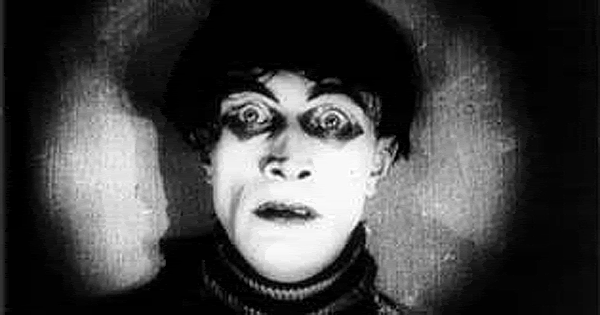Directed by Robert Wiene, The Cabinet of Dr Caligari is arguably one of the most influential films in the history of film making and laid the foundations for the modern day silver screen. Werner Krauss plays the role of Dr Cagliari, a carnival hypnotist who's main attraction is a somnambulist named Cesare. After a series of murders take place in a quaint German village the audience discover Dr Caligari is not just a mere
showman and entertainer but the blackhearted mastermind behind them, or so it seems.
The hero of the film Francis (Friedrich Feher) goes on a wild goose chase to uncover the murderer who is stalking the village. He is the stereotypical hero of silent films, driven by the will to do right and save those which he loves in this case his fiancée, Jane (Lil Dagover). Francis suspects Dr Caligari of being the perpetrator and pursues the man he believes is responsible.
The Cabinet of Dr Caligari is perhaps best know as being the film that heralded German Expressionism and Film Noir to cinema. The sharp pointed edges and unbalance of the scenery give the notion that it is a world in chaos and peculiarity "The bizarre slants and diagonals result in vivid, dreamlike logic and a terrifying lack of control." (Anderson,2008) While most films of the day focused on making the environment perfect The Cabinet of Dr Caligari did not "Radical distortions immediately set the film apart from earlier ones, which were based on the camera's innate tendency to record reality."(Ebert, 2009). This technique has been adopted by many other directors up until the present day, including Tim Burton in the 90's classic 'Edward Scissorhands'. The set looks overtly fake and cheap, the jagged cardboard edges and peculiar quilted designs are completely out of character for films of this era. However as the tale unfolds and the audience are pulled to the dramatic twist at the end Wiene's reasoning for constructing a set in this manner become apparent. "When the ultimate revelation comes in the film's final minutes-the many pieces of the quixotic puzzle fall into their perfectly logical places.(Humanick, 2007)
In the nail biting climax of the film we find that the flashback of Francis is all imagined in his fantasy world.The audience discover that he, Cesare and his beloved Jane are in fact patients at the local insane asylum and the man known as Caligari is the asylum doctor responsible for looking after Francis. The scenery is strongly influenced by psychoanalysis and this unsymmetrical environment illustrates the unbalance in the mind of Francis.
List of Illustrations
Fig 1. The surreal setting
Fig 2. Jane
Fig 3. Cesare
http://photobucket.com/images/the%20cabinet%20of%20dr%20caligari/
Bibiography
Jeffery M Anderson of Combustible Celluloid (published February 13 2008) http://www.combustiblecelluloid.com/classic/cabcaligari.shtml (accessed on 01,11,2011)
Roger Ebert of the Chicago Sun Times (published June 3 2009) http://rogerebert.suntimes.com/apps/pbcs.dll/article?AID=/20090603/REVIEWS08/906039987/1023 (accessed on 01,11,2011)
Rob Humanick of Projection Booth (published January 13 2007) http://projectionbooth.blogspot.com/2007/01/cabinet-of-dr-caligari.html (accessed on 01,11,2011)





No comments:
Post a Comment